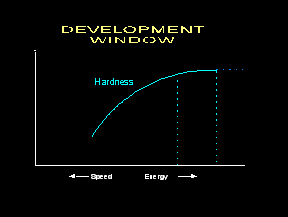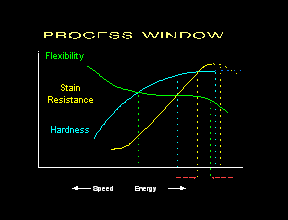Guide to UV Measurement
Optimizing the Cure Process - The “Process Window”
One of the objects of process development is to yield a process that will operate successfully in a reasonably wide range of conditions. The wider this range, or “window,” the more forgiving the process will be in production and less vulnerable to failure. The desired result is a robust process. The initial step in the development of a process is the identification of the physical properties that determine success. These properties must be measurable.
1. Applying a “cure ladder,” determine the upper and lower limits of achievement of target properties. Very often, only one of the limits is evaluated. In the example of hardness, it can be seen that the result of excessive energy is brittleness. The “window” of exposure to achieve the desired result is clearly identified.

2. Find the upper and lower limits of all properties critical to success;
3. Plot these limits on the energy diagram

4. Identify the limiting properties of the aggregate “window” and evaluate how they are affected by changes in: UV wavelength, irradiance, IR, or formulation. The aggregate “window” will show which properties are limiting the process. Three typical properties are shown in the example. By considering which exposure characteristic has the most effect on surface cure, bulk cure, and deep cure, the choice of which exposure variable to alter becomes clear.
- Peak irradiance affects depth of cure and efficiency;
- Short wavelengths affect surface properties;
- Long wavelengths affect deeper and bulk properties.
This method can be used to improve any UV curing process, but requires a set of versatile UV lab tools.